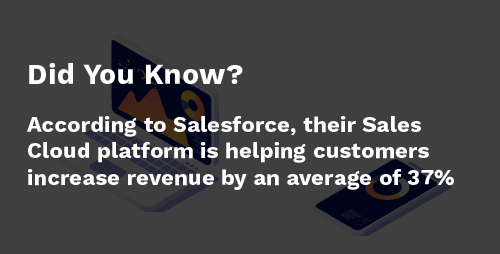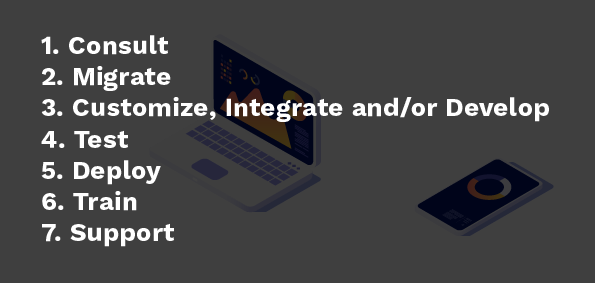Does Your Business Need a CRM Solution?
Salesforce is a Customer Relationship Management (CRM) solution that ties together all required departments of a business: marketing, sales, analysts, services, etc, under one integrated CRM platform. With high level insights into each individual customer, Salesforce helps create a seamless ecosystem between companies and customers.

Is it worth it? Salesforce claims that their Sales Cloud platform is helping customers increase revenue by an average of 37%! That’s indeed incredible. Here are some features you can expect when you implement Salesforce:
- Contact Management
- Customer Engagement Tools
- Workflow Creation
- Task Management
- Opportunity Tracking
- Collaboration Tools
- Analytics
- Intuitive, Mobile-Ready Dashboard
- Marketing Leads Monitoring
- Social Media Integration
- Email Integration
- Features for Salespeople
- Sales Leads Monitoring
- Communities for Sales
- Sales Forecasting
From the list you get an idea of the capabilities Salesforce arms your teams with. These features helps tie up all departments involved in lead nurturing and in customer services, be it for sales, marketing, or support.
In this article, we talk about the 5 core steps we as a Salesforce implementation partner follow in order to help our customers grow with Salesforce. These of course depend on the type of business we are working with, but usually the overall implementation falls into the following 5 buckets:
- Strategizing
- Planning the Implementation Phase
- Schedule and Budget Planning
- Risk & Mitigation Planning
- Salesforce Implementation & Adoption
Step 1: Implementation Strategies
The first step is to lay out what exists: the processes, technology, infrastructure, departments, etc. We as an integration partner design a Salesforce implementation strategy depending on what exists and the outcome you’re looking to achieve.
For example, if you have a sales and marketing team, we know that features like engagement tools, email integration, analytics, etc need to be set in place. If you’re happy with the current processes, the plan will be to implement Salesforce around the current processes to help you maximize output and growth with current processes intact. If you’re looking for process changes as well, we work together towards either implementing Salesforce and redefining your internal processes around Salesforce’s default processes, or we first tailor your internal processes to better suit your desired outcome and then implement Salesforce around.
Once the processes are defined and the implementation strategy is in place, we take a decision on executing the strategy in one of two ways:
- Implement multiple Salesforce cloud tools at one time. Or,
- Implement Salesforce cloud tools one at a time.
This decision is taken based on how interdependent departments and processes are. The advantage of implementing multiple cloud tools (say Sales Cloud, Marketing Cloud, and Service Cloud) all at once, is that all processes get automated and streamlined in parallel which yields maximum results, fast. The downside, however, is that if one department fails (due to miscalculated process definition or cloud implementation), all connected departments will experience downtime.
The risk of downtime is reduced (or even eliminated) when cloud tools are implements one department at a time. This gives your business an opportunity to understand the impact of Salesforce, normalize day-today operations, then implement subsequent cloud tools again, one by one.
Step 2: Planning the Implementation Phase
The implementation of a CRM differs from business to business, but largely the following steps are followed with the previously defined strategy kept in mind:

- Once the process and tools are planned out (in step1), we plan out the actual implementation steps. First we understand your business requirements, study the current technology and infrastructure, and give you an idea of the tools and licenses you will need to procure.
- We then plan out the migration of data from existing tools that are in place to the CRM.
- The next step is to plan out what tools stay, what will be modified, and what needs to be developed from scratch.
- We then set up a staging location in order to build a test version of the CRM.
- Once the QA testing is done, the solution is pushed to live servers.
- Your organization staff needs to be trained to effectively use the CRM for best results.
- We plan the terms of post execution support.
Each of the above steps are planned and an execution blueprint is set in place.
Step 3: Schedule and Budget Planning
Once the strategy and implementation plan are in place, your integration partner will know exactly how many modules are going to be implemented and the scope of activities will be defined. This lets us establish an estimated schedule for the completion of the project.
The budget is also determined at this point, as Salesforce licensing costs depend on the number of cloud solutions that are being implemented. The overall cost usually depends on:
- Partner fee (cost for consulting, planning, integration, development, training, support, etc).
- Number of products and product edition.
- Potential user count.
- Data migration charges.
Step 4: Risk & Mitigation Planning
Certain risks or issues need to be calculated before implementing a solution as large as a CRM. Risks could include irrelevant features, a setup that is not user friendly, budgeting or scheduling conflicts, etc. These risks need to be mitigated, and that could mean going back to step 1 in order to fine tune the strategy and the plan.
Step 5: Salesforce Implementation & Adoption
The final step, is implementing Salesforce CRM. The solution will first be built on a staging server and tested. Once all QA checks are passed, the final product will be rolled out to live servers. Employees will be trained on how to use the different features and businesses will need to ensure there is a transition from legacy methods to the CRM.
Partner With an Experienced Salesforce Integration Expert
Integrating a CRM needs proper planning, testing and execution. Finding a solutions partner who has in depth knowledge of and experience working with Salesforce, and one that has the capability to understand your business will make the entire process productive and efficient. Salesforce integration is a niche service of ours. Drop in a message and lets get a conversation started.

